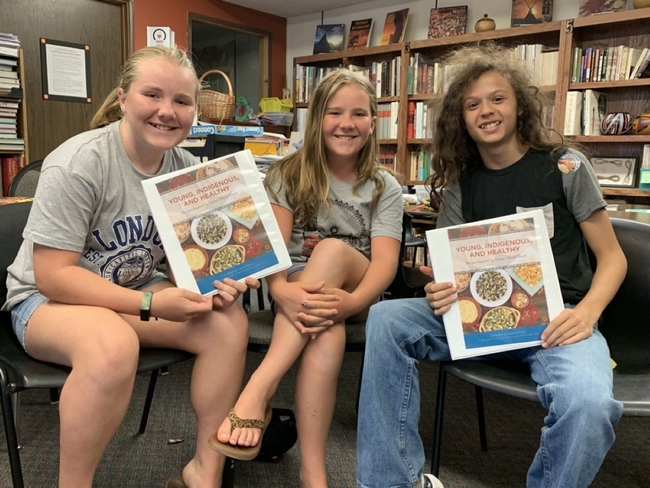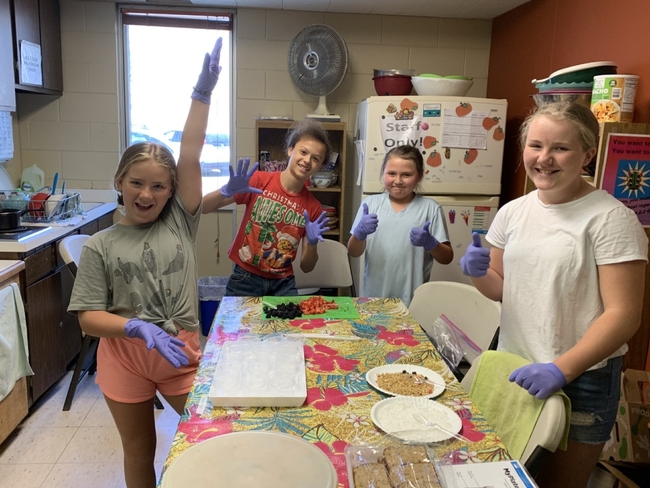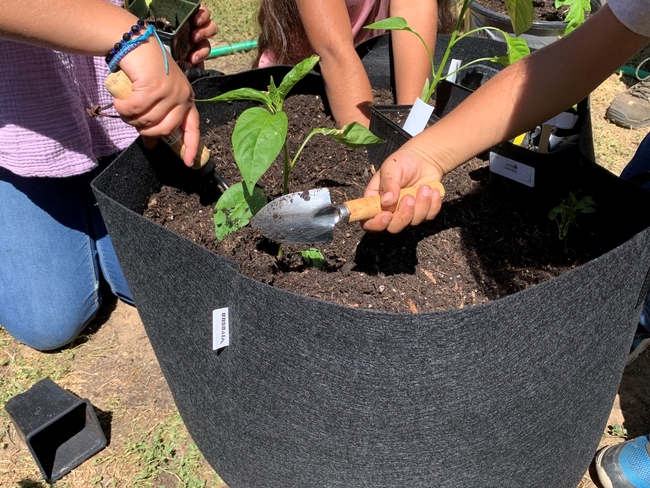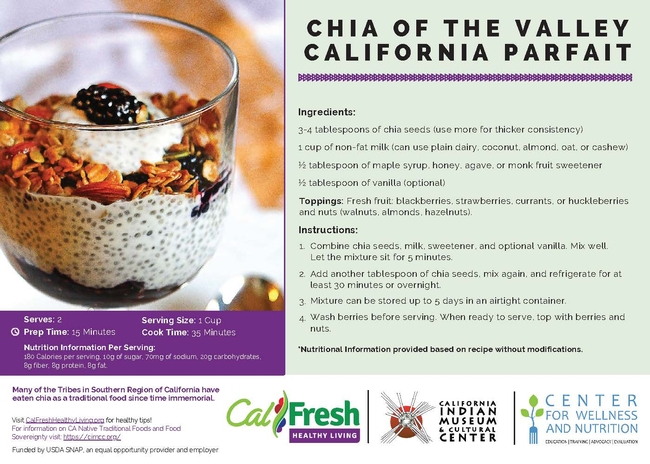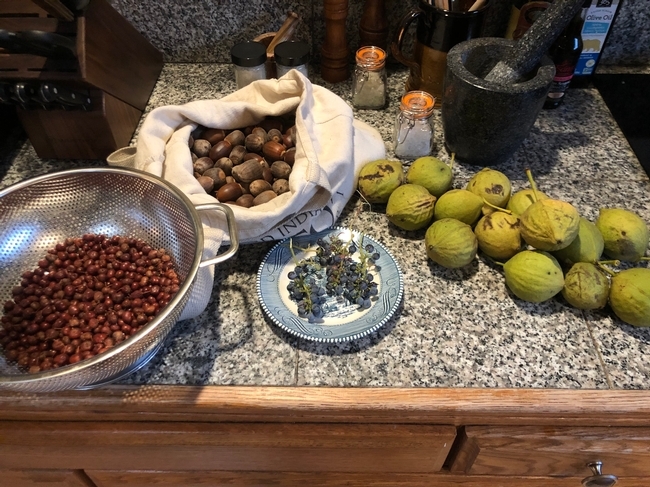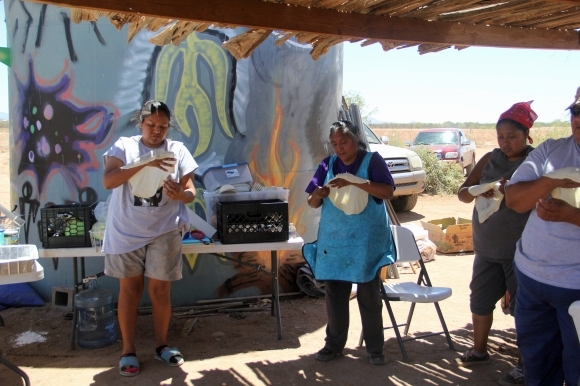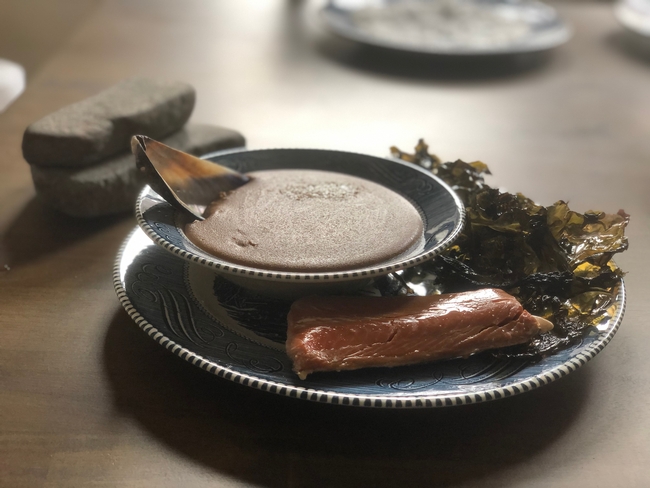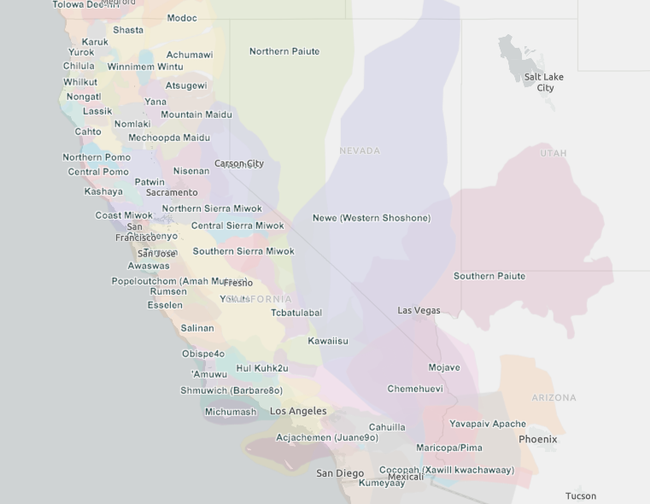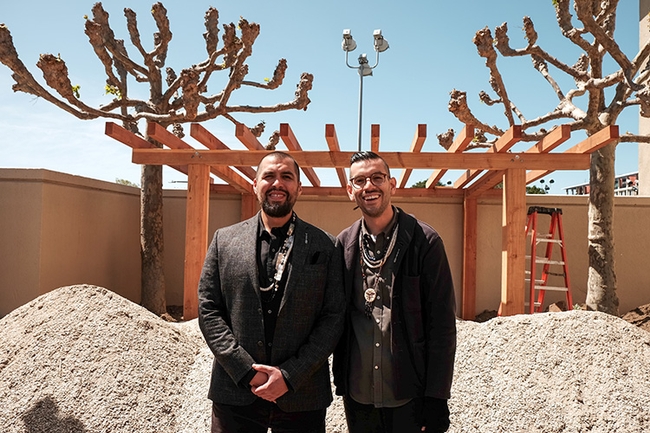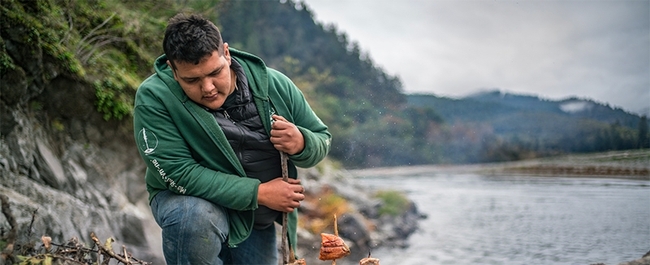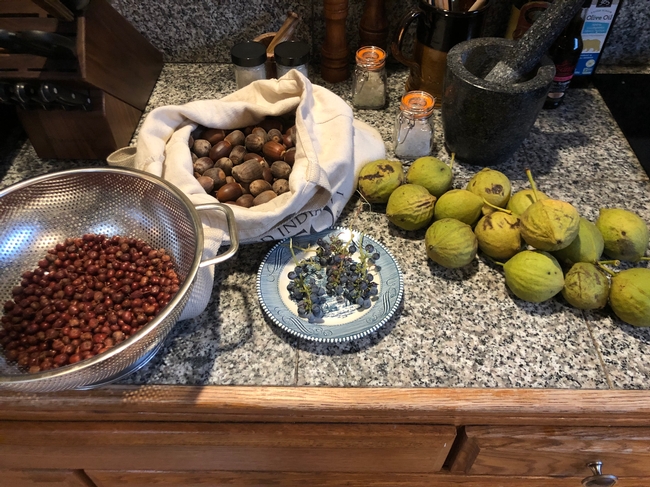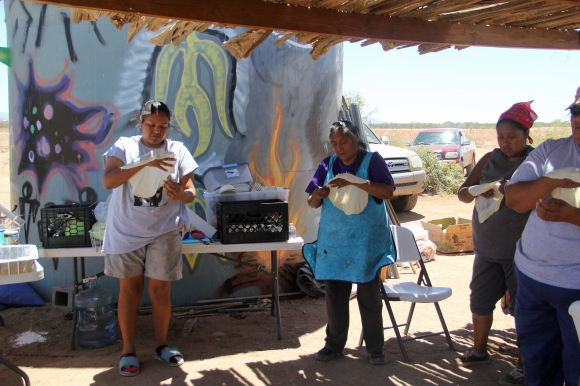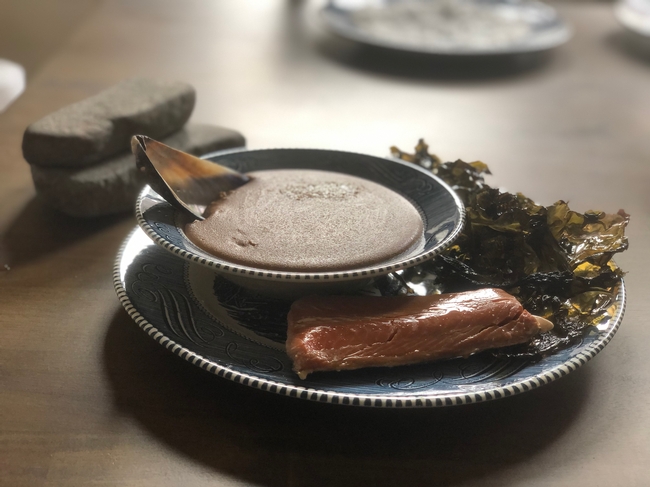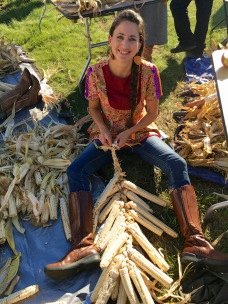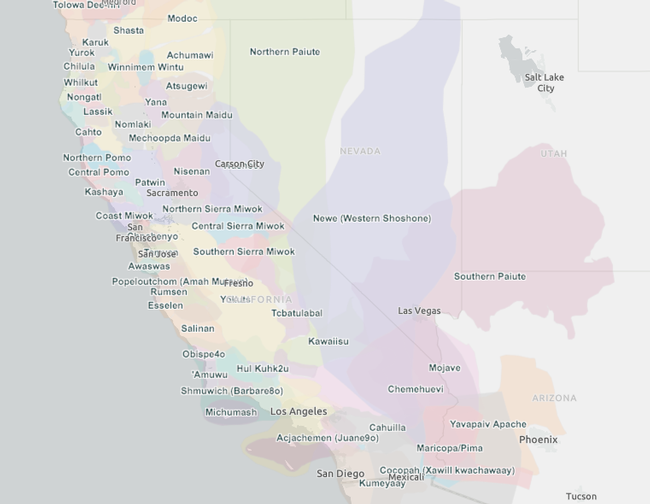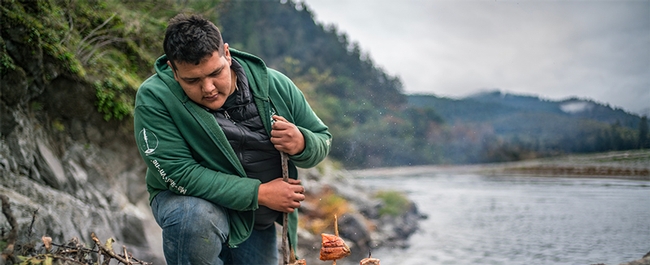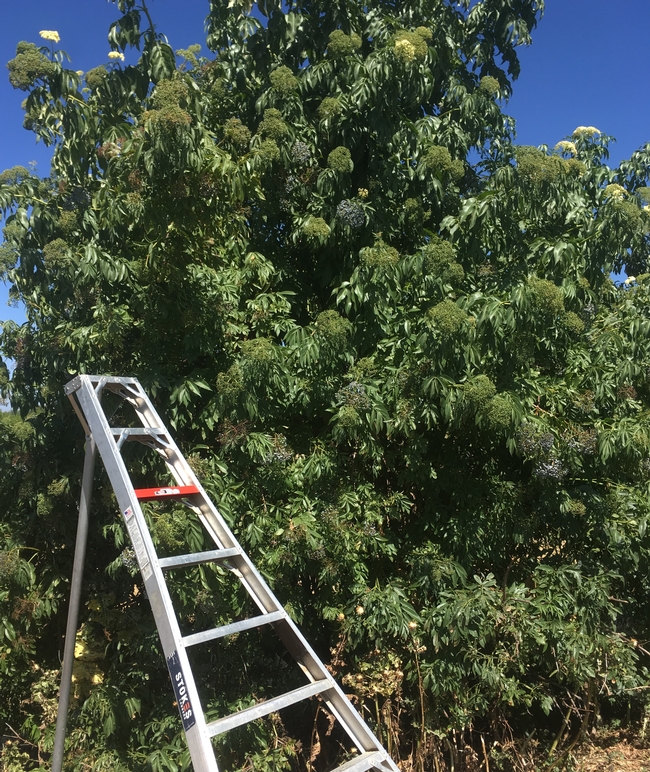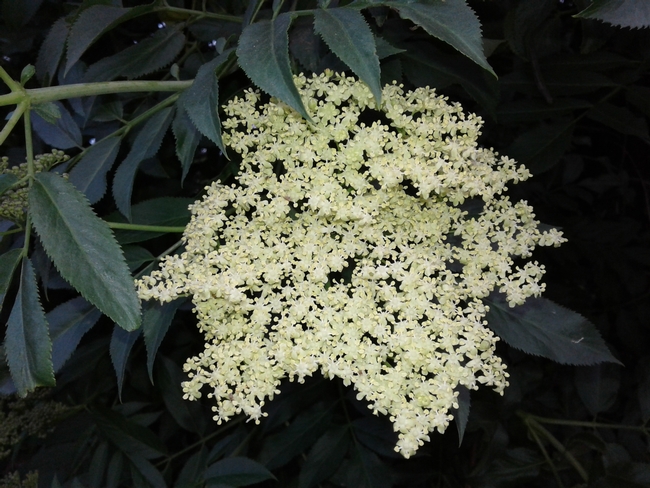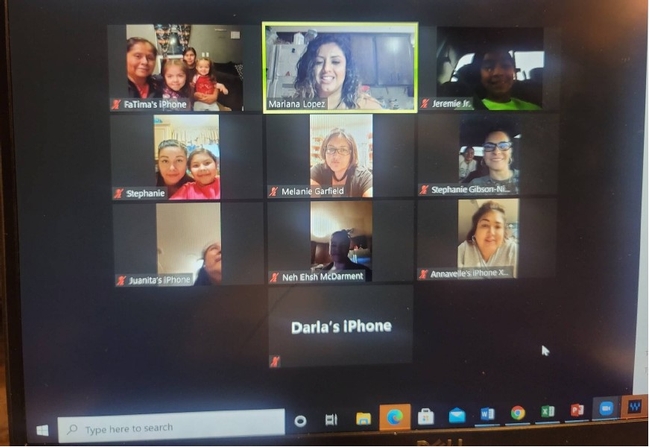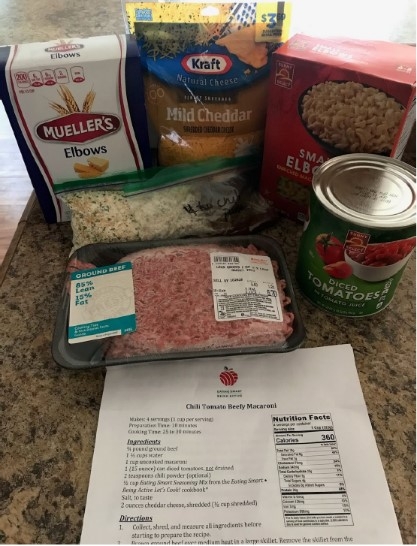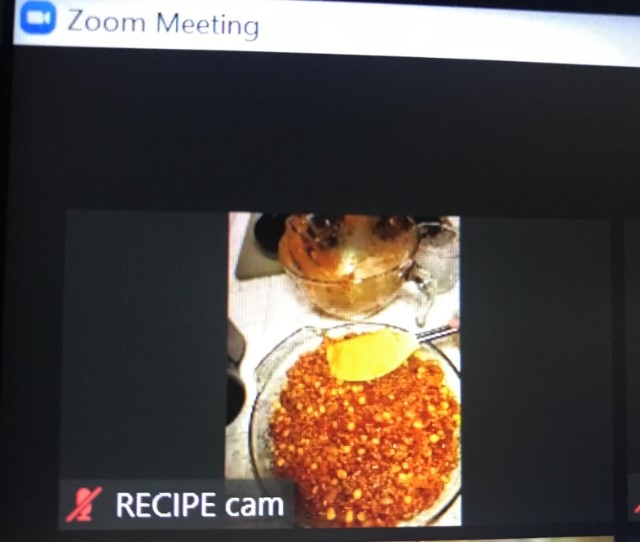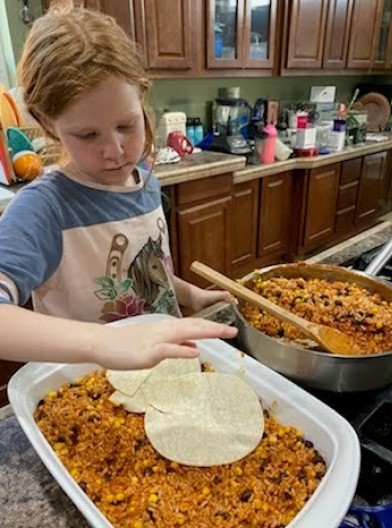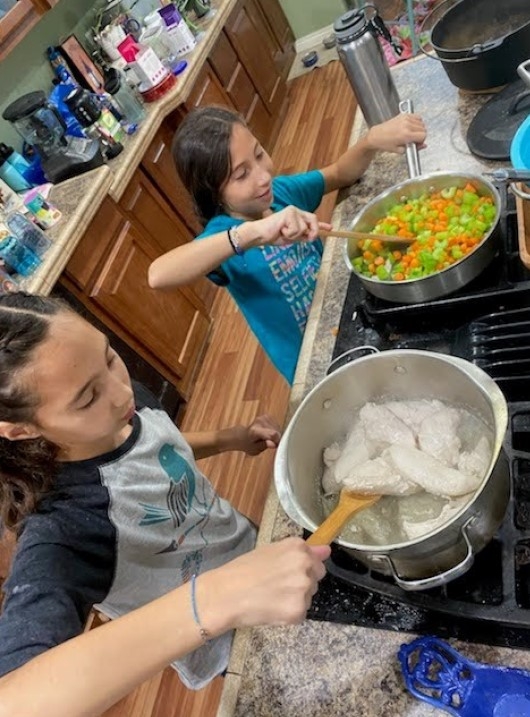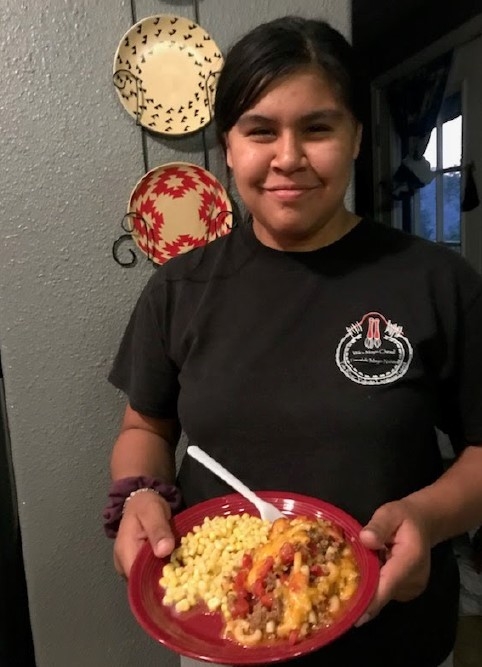Posts Tagged: Native American
CalFresh Healthy Living, UC helps connect Native youth with Native foods
Program with Foothill Indian Education Alliance teaches healthy eating to young people of many tribes
More than a tutoring center, the Foothill Indian Education Alliance facility in Placerville also provides cultural activities for youth in El Dorado and Amador counties affiliated with a broad diversity of Native American tribes.
In addition to traditional crafts like drum- and jewelry-making, the center began offering a food component last summer, through a partnership with CalFresh Healthy Living, University of California – one of the agencies in the state that teaches nutrition to people eligible for SNAP (Supplemental Nutrition Assistance Program).
“A lot of the kids, because they don't live on a reservation or their family might not be connected to a local tribe, don't know a lot of their history or their foods,” said Cailin McLaughlin, nutrition educator for CalFresh Healthy Living, UC, based at the UC Cooperative Extension office in El Dorado County. “Food is a good way to explore any heritage because food is at the central point of a lot of cultures and customs – sharing meals and sharing stories behind it.”
Last spring, McLaughlin worked with Hal Sherry, the head tutor at Foothill Indian Education Alliance, to create a new, five-week “summer camp” during which youth would learn about and prepare Native foods in the center's kitchen, primarily with ingredients from its backyard garden.
Sherry said that the experience provided the participants – 10 elementary school students and seven middle or high school students – an important perspective on the interconnectedness of all living things.
“Part of the objective of the program is for them to understand that each one of us is part of the natural order of things, and that we have to do our part to fit into that cycle,” he explained. “There's kind of an ecological lesson that's also being learned…and we don't want to put poisons in our bodies, and we don't want to put poisons in our environment.”
Program combines cultural lessons, nutrition information
For the summer program, McLaughlin selected a curriculum centered on garden-based nutrition, and infused it with elements of Indigenous food ways.
“We predominantly picked ingredients that had cultural significance to Native American communities, so things like blueberries, blackberries, pine nuts, squash, things of that nature,” she said. “So we could feed into the history of that ingredient, why it's important to the Indigenous communities – and then give (the students) the nutritional information about it.”
After the youth prepared chia seed parfaits – from a recipe that is part of a series developed by CalFresh Healthy Living, the California Indian Museum and Cultural Center, and the Center for Wellness and Nutrition – a Foothill Indian Education Alliance staff member shared that Native hunters would eat chia seeds for strength before a long hunt.
Many of the participants had never had chia seeds before, and the parfaits were an “absolute favorite,” in the words of McLaughlin.
“I wish we could have made them more often!” said Lacey, a fifth grader who participates in the center's programs year-round.
In addition to working outside in the garden, Lacey said she also liked cooking in the kitchen during the summer camp – and the fact that the young people could take the lead.
“It was all the kids doing it, but (McLaughlin) was just supervising and making sure we were doing it right – it was really nice,” said Lacey, who identifies as Miwok.
Sharing within families, across tribes
Active participation by the young people is one of the strengths of the program, according to Sherry. He expressed admiration for McLaughlin's engaging teaching style, which eschews “lectures” and instead draws the participants into lively conversations about the nutritional content of the ingredients.
“Hopefully they're going to retain some of that knowledge and information and then remember: ‘You know what, yes, I think I would like to have some corn and some beans tonight, because that's going to help my bones grow strong and my eyesight get better,'” Sherry said. “That's really a big part of what we want them to come away with.”
At the end of the summer program, participants also came away with a binder of recipes from a cookbook of Native American dishes, “Young, Indigenous and Healthy: Recipes Inspired by Today's Native Youth.” James Marquez, director of the Foothill Indian Education Alliance, said he heard from students that they were bringing many of the lessons from the program back to their homes.
“I've heard the same kind of thing from parents and grandparents, who have said how wonderful that was and that kids come back home and have an interest in cooking and trying to serve nutritious meals to their families,” Marquez said.
That crucial sharing of knowledge also happens between and among staff members and students, as the center comprises members of many tribes, from South Dakota Lakota to Navajo.
“We serve Native people, we don't care what tribe they come from – they're all welcome,” Marquez said. “What we do represents a lot of different tribes, so we share information from one tribe to another, and that way people can appreciate everybody and what we have to bring to the table.”
Talia, a sixth grader who participated in the summer program, said that she enjoys that cultural sharing.
“I like how I can learn new things…and how I learn more about the people around me,” she explained. “It's also fun to learn about other people's cultures, and what Native American they are, too.”
McLaughlin went on to partner with Foothill Indian Education Alliance on a “Cooking Academy” program during this past fall, and is planning another spring/summer program for 2023, as well. The ongoing teaching and sharing of food ways is just one part of a long process to recover and rebuild Native American cultural traditions.
“Unfortunately, there was a very concerted effort to obliterate the Native culture on this continent; it was a very intentional, very deliberate effort to just stamp that culture out like it had somehow never existed,” Sherry said. “Now there's a much greater awareness of what a terrible thing that was, and so it's like trying to regrow a new garden over an area that was severely burned…and it's being done all over the country.”
Books, videos and songs highlight Native views on ‘thanksgiving’
UC takes some first steps in addressing historical wrongs
Thanksgiving can be a time of celebration, gratitude and sharing. It is also often a time when people assist the most vulnerable in our communities, through donations to food banks, volunteer service and similar acts of compassion. But it is also a time of remembrance and mourning in Native American communities.
The narrative that many people have been taught beginning in elementary school about the First Thanksgiving celebration in the United States is based on historically inaccurate myths that fail to acknowledge the devastation wrought by settler colonialism, including genocide, land theft, forced assimilation and cultural appropriation.
Many Native people refuse to celebrate Thanksgiving; some engage in a day of mourning, protesting the genocide wrought on their ancestors and ongoing oppression. Native scholar Philip Deloria (Standing Rock Sioux) wrote about some elements of this in his contribution to The New Yorker several years ago, but for additional information interested readers could also turn to the essay“Deconstructing the Myths of ‘The First Thanksgiving'” by Judy Dow (Abenaki) and Beverly Slapin.
Educators – in formal and informal settings – play an important role in spreading awareness of the atrocities experienced by Native peoples at the hands of the European settlers. In April of this year, University of California President Michael Drake recognized and acknowledged the historical wrongs endured by Native Americans in announcing the UC's Native American Opportunity Plan, which covers tuition and fees for California students from federally recognized tribes. But the statement fell short of acknowledging the ways in which UC has and continues to benefit as a result of those wrongs.
Free tuition for California Native Americans was one of the recommendations in the 2021 report “The University of California Land Grab: A Legacy of Profit from Indigenous Land,” co-authored by UC Berkeley's Native American Student Development program and the Joseph Myers Center, based on a two-part workshop series held in 2020 and covered recently in the June 2022 issue of UC Berkeley's alumni magazine.
While the new UC tuition and fee remission plan is a big step in the right direction, it excluded the many California Native Americans who are not members of federally recognized tribes. Fortunately, the Federated Indians of Graton Rancheria created a scholarship fund to cover tuition and fees for these students.
Another important step that University of California Agriculture and Natural Resources is taking, in alignment with recommendations from the “Land Grab” report, is the recruitment of three new UC Cooperative Extension academics centering Indigenous communities and perspectives on topics related to farming and food sovereignty, climate resilient disaster planning and policy, and beneficial burning and Indigenous land stewardship.
The focus of these positions acknowledges the importance of strengthening partnerships with Native American communities, uplifting their voices, leadership, concerns and solutions around addressing some of the most pressing environmental and societal challenges facing California communities today. Voices from the Washoe Tribe, for example, were central in the recent UC California Naturalist statewide conference along the north shore of Lake Tahoe.
Native perspectives on thanksgiving
Celebrations of harvest certainly did not originate with settlers and Native Americans sharing a meal in the 17th century. Rather, they have been integral to the fabric of Indigenous existence since time immemorial, as Native communities view “thanksgiving” as a time for honoring the ancestors, which includes the lands, plants and animals that are understood as relations.
In her book, “Braiding Sweetgrass,” Robin Wall Kimmerer describes how the Haudenosaunee people (in the northeastern U.S. and southeastern Canada), recite the Thanksgiving Address, “a river of words as old as the people themselves” known in the Onondaga language as the Words that Come Before All Else, “whenever they gathered…before anything else was done. ”
At its core, the Thanksgiving Address is an expression of gratitude for “the ones who share their gifts with the world,” including the water, the fish, the plant foods and medicines, the animals, the winds, and the sun and the moon and the stars.
Taking a decolonizing approach to Thanksgiving rejects the myths of Thanksgiving and harmful stereotypes about Native peoples that reinforce oppression, and invites opportunities for deepening a collective understanding of Indigenous history, amplifying Native perspectives that highlight the diversity of Indigenous peoples and foodways, and support Native-led food sovereignty and land stewardship initiatives that affirm contemporary presence and self-determination of Native people in 21st century America.
UC Berkeley Professor Peter Nelson (Coast Miwok and tribal citizen of the Federated Indians of Graton Rancheria) offers this helpful insight: “We have plenty of points at which we give thanks for what our non-human relations give us or honor the changing of the seasons and gathering times. The fall in my language, Coast Miwok (Tamal Machchaw), is ‘umpa walli' or ‘acorn time.' Some of these concepts don't exactly translate from English. ‘Thank you,' or ‘ka molis,' means something more like ‘I'm glad/happy.' We express a state of being or how it makes us feel. The same is true of the concept of ‘I'm sorry,' which doesn't exist in our language. We have to contrive something to the effect of ‘my heart is sad' – ‘ka wuskin sawa.' Again, a state of being and there is a sense that you should just express how to fix things if they are out of sorts. Hearing a settler apology isn't enough. Do something about it.”
What can you do?
Below are just a few ideas of how you can learn about the authentic history of Native Americans and center your Thanksgiving messaging around social and environmental justice. Equally important, through these resources, you can learn about contemporary Native American peoples and communities in both urban and rural areas.
Also included are ways to support the growing Indigenous food sovereignty movement among Native Americans to reclaim and restore their food systems through ecological and cultural restoration and self-determination.
Decolonizing the history and meaning of Thanksgiving
- Read the stories of four East Bay residents and their personal family traditions for the fourth Thursday in November: https://www.berkeleyside.org/2022/11/16/celebrate-thanksgiving-respectfully-indigenous-native-people.
- Share these powerful short videos on Thanksgiving word association and Native people describing Thanksgiving that are helpful for understanding the Native American perspective on the holiday.
- View this brief speech by Linda Coombs (Aquinnah Wampanoag), who used to direct the Wampanoag Indigenous Program and Plymouth Plantation, at the site of the presumptive original Thanksgiving meal, for a greater perspective on the myths surrounding the origins of Thanksgiving.
- Also read this speech that Frank James attempted to deliver before the 1970 Pilgrim's Progress parade in Plymouth. His rejection after the organizers heard the content of his speech led to the National Day of Mourning counter-parade that takes place each year.
- This article, “The Thanksgiving Tale We Tell Is a Harmful Lie. As a Native American, I've Found a Better Way to Celebrate the Holiday,” is a helpful resource where “Sioux Chef” Sean Sherman (Oglala Lakota) makes the case for focusing Thanksgiving on values that apply to everybody: togetherness, generosity and gratitude – as well as embracing Indigenous foods, which are centrally featured in Thanksgiving meals including turkey, corn, beans, pumpkins, maple, cranberries, wild rice, etc.
- An excellent compilation of resources for youth and families by Lindsey Passenger Wieck, can be found in “Decolonizing Thanksgiving: A Toolkit for Combatting Racism in Schools,” that includes books, articles and inspirations for lesson plans, several of which are listed below.
- Helpful book suggestions and educational resources for teaching Thanksgiving in a socially responsible way, including lesson plans for all ages, are provided by the Southern Poverty Law Center at https://www.tolerance.org/magazine/teaching-thanksgiving-in-a-socially-responsible-way.
Learn about the Indigenous history of the United States and the Native lands and people where you live
- Read Peter Nelson's “Where Have All the Anthros Gone? The Shift in California Indian Studies from Research “on” to Research “with, for, and by” Indigenous Peoples”: https://anthrosource.onlinelibrary.wiley.com/doi/10.1111/aman.13633.
- Spend some time researching the environmental and cultural history of the lands where you are standing, starting with identifying whose lands you are residing in via this interactive map of Indigenous territories and learning about how you can support them.
- Learn about how the University of California and the other land-grant institutions of higher education were founded upon the expropriation and sale of Indigenous lands that were “granted” to every state under the Morrill Act in this High Country News article and this UC Land-Grab Workshop series. On this interactive map created by UC IGIS at https://arcg.is/1GTiuv, you can identify specific parcels that were “granted” and the Native communities from whom they were taken.
- Read “The University of California Land Grab: A Legacy of Profit from Indigenous Land,” a report based on the proceedings of the 2020 University of California Land Grab forum by Rosalie Zdzienicka Fanshel, Phenocia Bauerle (Apsaálooke), Deborah Lustig and Jennifer Sowerwine. (Executive summary)
- Educate yourself about the history of Indigenous peoples and the American genocide in the United States. Here are some recommended titles:
- Benjamin Madley's “An American Genocide: The United States and the California Indian Catastrophe, 1846-1873”
- “Custer Died for Your Sins” by Vine Deloria (Standing Rock Sioux)
- Roxanne Dunbar Ortiz's “An Indigenous Peoples' History of the United States”
- Dee Brown's classic “Bury My Heart at Wounded Knee”
- Learn about Indigenous ways of knowing and Native Science. Again, here are some recommended titles:
- “Braiding Sweetgrass”by Robin Wall Kimmerer (Citizen Potawatomi)
- “Decolonizing Methodologies: Research and Indigenous Peoples” by Linda Tuhiwai Smith (Maori)
- “Indigenous Methodologies: Characteristics, Conversations and Contexts” by Margaret Kovach (Nêhiyaw and Saulteaux ancestry from Treaty Four, Saskatchewan; enrolled member of Pasqua First Nation)
- “Native Science: Natural Laws of Interdependence” by Gregory Cajete (Santa Clara Pueblo)
- Learn about how Native Americans have managed California's landscape since time immemorial in Kat Anderson's best-selling book “Tending the Wild: Native American Knowledge and the Management of California's Natural Resources”
- Share what you learn with those in their formative years. There are numerous websites with information decolonizing Thanksgiving (only some of which are referenced above), and both “Indigenous Peoples' History of the United States”(Dunbar-Ortiz) and “Braiding Sweetgrass” (Kimmerer) are available in modified versions aimed at young adult readers.
Learn about, support and amplify Native-led food sovereignty and land-stewardship initiatives in California
- Feature Native chefs in your communications such as Vincent Medina (Chochenyo Ohlone) and Louis Trevino (Rumsen Ohlone) of ot?t?oy/Café Ohlone and Crystal Wahpepah (Kickapoo) to honor their Indigenous food heritage; a PBS NewsHour crew recently featured ottoy, a collaboration between Cafe Ohlone and the Phoebe A. Hearst Museum of Anthropology, and the efforts of the museum to change its approach to repatriation of ancestral remains, funerary objects and objects of cultural patrimony.
- Dine at Cafe Ohlone, which is located at UC Berkeley.
- Watch the film “Gather,” featuring Indigenous chefs, scientists and activists around the country working to restore their spiritual, political and cultural identities through food sovereignty, including Samuel Gensaw (Yurok), co-founder of the Ancestral Guard, committed to restoring the foodways of North Coast California.
- Read about Indigenous foodways initiatives through Civil Eats reporting.
- Promote Native food purveyors, and other Native-owned businesses not only in November but year-round, as a way of honoring Native culture and ethical practices. The Intertribal Agriculture Council's American Indian Foods Program showcases American Indian food businesses and their products, many of which are grown following traditions of their ancestors.
- Learn about and support Indigenous-led land stewardship efforts to restore cultural burning practices by the Karuk Tribe, the Amah Mutsun Land Trust and the North Fork Mono Tribe, among others, to enhance healthy relationships with the land and mitigate against catastrophic fires that have devastated California communities and ecosystems.
- Read the First Nations Development Institute's report on California Indigenous land stewards for more information on both urban and rural Indigenous-led stewardship initiatives and Native perspectives across the state, including the Sogorea Te' Land Trust, an urban Indigenous women-led community organization that facilitates the return ofChochenyo andKarkinOhlone lands in the San Francisco Bay Area to Indigenous stewardship.
Honoring Native people and perspectives on Thanksgiving
- In addition to reading, you may consider visiting a local Native American museum or cultural center during some part of the holiday (courtesy of Eve Bratman) – or on December 3 for the upcoming first annual Tribal Museums Day.
- Play the song “Custer Died for your Sins” and other songs of Indigenous resistanceas music during your celebration. For starters, check out Rebel Beat Radio and Indigenous Resistance (courtesy of Eve Bratman).
- Take a moment of silence and remembrance for ancestors and the people whose land you are occupying, before your meal. Set intentions to learn more and take action to support Native people.
Native people take a different view of Thanksgiving
The narrative that many people have been taught beginning in elementary school about the First Thanksgiving celebration in the United States is based on historically inaccurate myths that fail to acknowledge the devastation wrought by settler colonialism, including genocide, land theft, forced assimilation and cultural appropriation.
Many Native people refuse to celebrate Thanksgiving; some engage in a day of mourning, protesting the genocide wrought on their ancestors and ongoing oppression. Others pay respect to time-honored values and traditions centering on family, the earth and the harvest. As educators, it is important for us to understand the atrocities experienced by Native peoples at the hands of the European settlers, and Native perspectives about thanksgiving—a time of honoring the ancestors including the lands, plants and animals that are understood as relations—when we are communicating about the meaning of the Thanksgiving celebration.
Celebrations of harvest certainly did not originate with settlers and Native Americans sharing a meal in the 17th century, but rather have been integral to the fabric of Indigenous existence since time immemorial, noted UC Berkeley Professor Elizabeth Hoover (Mohawk/Mi'kmaq descent).
“For Haudenosaunee people (in the northeast), the Thanksgiving Address (Ohen:ton Karihwatehkwen, the Words that Come Before All Else) is recited before every important event,” Hoover said. “There are thanksgiving feasts held when the thunders start, when the sap flows, when it's time for the seeds to be planted, when the first wild strawberries come out, when the green beans are ready, when the green corn is ready, when the harvest is ready — many times throughout the year.”
Taking a decolonizing approach to Thanksgiving rejects the myths of Thanksgiving and harmful stereotypes about Native peoples that reinforce oppression, and invites opportunities for deepening our collective understanding of Indigenous history, amplifying Native perspectives that highlight the diversity of Indigenous peoples and foodways, and support Native-led food sovereignty and land stewardship initiatives that affirm contemporary presence and self-determination of Native people in 21st-century America.
UC Berkeley Professor Peter Nelson (Federated Indians of Graton Rancheria) offers this helpful insight: “We have plenty of points at which we give thanks for what our non-human relations give us or honor the changing of the seasons and gathering times. The fall in my language, Coast Miwok (Tamal Machchaw), is 'umpa walli or acorn time. Some of these concepts don't exactly translate from English. ‘Thank you,' or ka molis, means something more like I'm glad/happy. We express a state of being or how it makes us feel. The same is true of the concept of ‘I'm sorry,' which doesn't exist in our language. We have to contrive something to the effect of ‘my heart is sad,' ka wuskin sawa. Again, a state of being and there is a sense that you should just express how to fix things if they are out of sorts. Hearing a settler apology isn't enough. Do something about it.”
Consider centering Thanksgiving messaging around social and environmental justice by sharing resources for learning about the authentic history of Native Americans, contemporary Native American peoples and communities in both urban and rural areas, and supporting the growing Indigenous food sovereignty movement among Native Americans to reclaim and restore their food systems througheco-cultural restoration and self-determination.
The following are resources suggested by Elizabeth Hoover, Peter Nelson and others to learn more about the perspective of Native Americans on the U.S. holiday.
Decolonizing the history and meaning of Thanksgiving:
- Share these powerful short videos on Thanksgiving word association and Native people describing Thanksgiving that are helpful for understanding the Native American perspective on the holiday.
- View this brief speech by Linda Coombs (Aquinnah Wampanoag), who used to direct the Wampanoag Indigenous Program and Plymouth Plantation, at the site of the presumptive original Thanksgiving meal, for a greater perspective on the myths surrounding the origins of Thanksgiving.
- Also read this speech that Frank James attempted to deliver before the 1970 Pilgrim's Progress parade in Plymouth. His rejection after the organizers heard the content of his speech led to the National Day of Mourning counter-parade that takes place each year.
- This article, “The Thanksgiving Tale We Tell Is a Harmful Lie. As a Native American, I've Found a Better Way to Celebrate the Holiday,” is a helpful resource where Sioux Chef Sean Sherman makes the case for focusing Thanksgiving on values that apply to everybody: togetherness, generosity and gratitude, as well as embracing Indigenous foods, which are centrally featured in Thanksgiving meals including turkey, corn, beans, pumpkins, maple, cranberries, wild rice, etc.
- An excellent compilation of resources for youth and families by Lindsey Passenger Wiek, can be found in Decolonizing Thanksgiving: A Toolkit for Combatting Racism in Schools, that includes books, articles and inspirations for lesson plans, several of which are listed below.
- Helpful book suggestions and educational resources for teaching Thanksgiving in a socially responsible way, including lesson plans for all ages, are provided by the Southern Poverty Law Center at https://www.tolerance.org/magazine/teaching-thanksgiving-in-a-socially-responsible-way.
Learn about the Indigenous history of the United States and the Native lands and people where you live:
- Read Peter Nelson's Where Have All the Anthros Gone? The Shift in California Indian Studies from Research “on” to Research “with, for, and by” Indigenous Peoples.
- Spend some time researching the environmental and cultural history of the lands where you are standing starting with identifying whose lands you are residing in via this interactive map of Indigenous territories and learning about how you can support them.
- Learn about how the University of California and the other land grant institutions of higher education were founded upon the expropriation and sale of Indigenous lands that were “granted” to every state under the Morrill Act in this High Country News article and this UC Land-grab Workshop series. On this interactive map created by UC IGIS at https://arcg.is/1GTiuv, you can identify specific parcels that were “granted” and the Native communities from whom they were taken.
- Read The University of California Land Grab: A Legacy of Profit from Indigenous Land, a report based on the proceedings of the 2020 University of California Land Grab forum by Rosalie Zdzienicka Fanshel, Phenocia Bauerle (Apsaálooke), Deborah Lustig, and Jennifer Sowerwine. Executive summary
- Educate yourself about the history of Indigenous peoples and the American genocide in the United States, by reading Benjamin Madley's An American Genocide: The United States and the California Indian Catastrophe, 1846-1873i, Vine Deloria's 1969 Custer Died for Your Sins, Dunbar Ortiz's An Indigenous Peoples' History of the United States, or Dee Brown's classic Bury My Heart at Wounded Knee.
Learn about, support and amplify Native-led food sovereignty and land-stewardship initiatives in California:
- Watch the film Gather, featuring Indigenous chefs, scientists and activists around the country working to restore their spiritual, political and cultural identities through food sovereignty, including Samuel Gensaw (Yurok), co-founder of the Ancestral Guard, committed to restoring the foodways of North Coast California.
- Read about Indigenous foodways initiatives through Civil Eats reporting.
- Feature Native chefs in your communications such as Vincent Medina and Louis Trevino of Café Ohlone and Crystal Wahpepah to honor their Indigenous food heritage.
- Promote Native food purveyors, and other Native-owned businesses not only in November but year-round, as a way of honoring Native culture and ethical practices.
- Learn about and support Indigenous-led land stewardship efforts to restore cultural burning practices by the Karuk Tribe, the Amah Mutsun Land Trust, and the North Fork Mono Tribe, among others, to enhance healthy relationships with the land and mitigate against catastrophic fires that have devastated California communities and ecosystems.
- Read the First Nations Development Institute's report on California Indigenous land stewards for more information on both urban and rural Indigenous-led stewardship initiatives and Native perspectives across the state, including the Sogorea Te' Land Trust, an urban Indigenous women-led community organization that facilitates the return of Chochenyo and Karkin Ohlone lands in the San Francisco Bay Area to Indigenous stewardship.
- Read Elizabeth Hoover's blog about Native American farming and food sovereignty http://gardenwarriorsgoodseeds.com.
Honoring Native people and perspectives on Thanksgiving:
- In addition to reading, you may consider visiting a local Native American museum or cultural center during some part of the holiday (courtesy of Eve Bratman).
- Play the song Custer Died for your Sins and other songs of Indigenous resistance as music during your celebration. For starters, check out Rebel Beat Radio and Indigenous Resistance (courtesy of Eve Bratman)
- Take a moment of silence and remembrance for ancestors and the people whose land you are occupying, before your meal. Set intentions to learn more about and take action to support Native people.
Jennifer Sowerwine, UC Cooperative Extension specialist at UC Berkeley, and Sabrina Drill, UC Cooperative Extension advisor in Los Angeles and Ventura counties, collaborate with Native Americans on environmental and food sovereignty research.
New guide shows how elderberry activates hedgerows, ecologically and commercially
A farm-edge hedgerow can be more than a boundary or barrier. When it comprises blue elderberry, it can be a way to integrate biodiversity in an often-simplified agricultural landscape – and connect with a legacy of stewardship and use by California's Native peoples.
A new guide, published by UC Agriculture and Natural Resources, provides detailed instructions and advice for California farmers on growing, harvesting and marketing blue elderberry. It is available as a free download in the UC ANR catalog at https://anrcatalog.ucanr.edu/Details.aspx?itemNo=8709.
“It's the only publication of its kind, that we know of, that focuses on commercial production of a native species from within a hedgerow, which people normally think of as a conservation feature,” said Sonja Brodt, one of the publication's authors and associate director of UC ANR's Sustainable Agriculture Research and Education Program.
In addition to illustrating the plant's many ecological benefits, “Producing Blue Elderberry as a Hedgerow-Based Crop in California” highlights the economic viability of the products made from its flowers, berries and other components.
“Consumer interest in elderberry products is booming,” said Brodt, “and blue elderberry has the potential to meet local needs with a locally adapted species that is climate-resilient, and can be produced in a relatively low-input way that supports – rather than displaces – our native ecosystems.”
The guide incorporates the findings of a UC SAREP project exploring the farm management practices, nutritional content and market potential of elderberry products. And Brodt emphasized that this resource also draws upon the deep knowledge of Indigenous people, as well as best practices of growers such as Katie Fyhrie, formerly of The Cloverleaf Farm in Dixon and another author of the guide.
“We originally got inspiration to do this work from local farmers who are pioneering the use of blue elderberry harvested on their farms, and from Native Americans in California who have long stewarded and utilized blue elderberry for food and other cultural uses,” Brodt explained.
The other publication authors are Gwenael Engelskirchen, sustainable supply chain analyst for UC SAREP; and Katie Uhl, graduate student researcher; and Alyson Mitchell, professor in UC Davis' Department of Food Science and Technology.
UC and community partners provided virtual hands-on cooking demonstrations
The Expanded Food and Nutrition Education Program (EFNEP) in Tulare County conducted virtual nutrition education and cooking demonstration classes last fall, empowering families to support their health with knowledge and skills to adopt healthy behaviors. The training covered nutrition/physical activity, food resource management, food security and food safety.
Step 1: EFNEP integrated virtual food demonstration in nutrition education classes
EFNEP Tulare collaborated with Native American Tribal organizations and Tulare Adult School to provide virtual food demonstration classes integrated with nutrition education to parents with children. Mariana Lopez, bilingual EFNEP adult nutrition educator, led the classes in English and Spanish in four 60- to 90-minute sessions over four weeks.
Step 2. Planning, preparation and implementation of virtual food demonstration
Community partners provided the ingredients to the participants. Lopez found ways to make the virtual food demonstration successful by planning and preparing ahead of time. Participants engaged in hands-on learning about cost-effective cooking at home. Participants learned about food planning, budgeting and shopping, healthy foods, food safety practices and physical activity.
Step 3. Family engagement during virtual food demonstration
Lopez conducted virtual nutrition education classes with 48 families; 38 families graduated.
Community partners expressed their gratitude and willingness to continue with the collaboration.
“The participants really enjoyed the class and wished it was longer. They looked forward to meeting each week and getting their food and cooking together with the nutrition teacher and their families.” - site manager
Participants engaged their families to enjoy the virtual food demonstration classes.
“Thank you. Class was fun being able to cook with my girls and I learned so much.”
~ class participant
Overall, EFNEP Tulare created excitement with virtual nutrition education classes through food demonstrations, promoted family engagement, strengthened community partnerships, and empowered families to be resourceful, eat healthy on a budget and live a healthy lifestyle.

